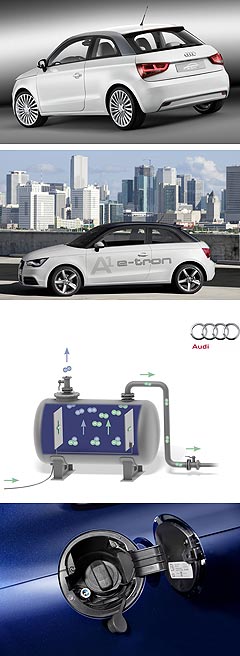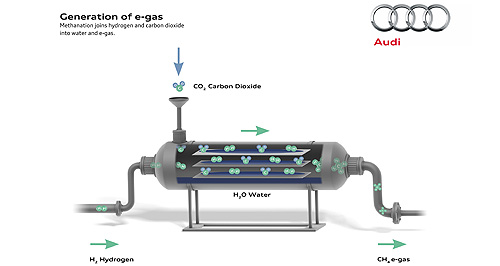News - AudiAudi invests in sustainable energyIt's a gas: The Audi A3 TCNG has a four-cylinder turbocharged internal combustion engine designed to run on compressed natural gas. Wind, solar and synthetic ‘e-gas’ part of Audi’s plan for a sustainable future2 Jun 2011 GERMAN luxury car-maker Audi is getting into the sustainable energy production business, as part of a project to produce carbon-neutral synthetic fuel that can be used to power cars, homes and businesses. Dubbed e-gas, synthetic methane – which is chemically identical to natural gas – is created by separating the hydrogen and oxygen molecules in water, then combining the extracted hydrogen with concentrated carbon dioxide from a waste-biogas plant (which would otherwise be released directly into the atmosphere), resulting in methane that can be fed into – and stored using – existing natural gas infrastructure. Although the project is taking place in Audi’s native Germany, the company says the technology could be implemented anywhere that has a public piped gas network, meaning that Australia could one day produce its own synthetic natural gas. The process of producing the hydrogen releases oxygen into the atmosphere and when the fuel is burnt, the resulting carbon dioxide emissions are equal to what was prevented from entering the atmosphere to start with, making the fuel carbon-neutral. The electricity required to power the electrolysis equipment that extracts the hydrogen from water comes from wind energy produced by four offshore wind turbines in the North Sea.  Left: Audi A1 e-tron. Below: Diagram of the e-gas system. Left: Audi A1 e-tron. Below: Diagram of the e-gas system.The turbines, which are jointly funded by Audi and a regional energy company, are capable of generating 53GWh of electricity annually – which Audi says is enough energy to power a medium-sized city. The company also claims that offshore turbines produce 40 per cent more energy than their onshore equivalents. Using hydrogen to produce methane also overcomes the problem of storing the highly-volatile hydrogen gas and provides a way of storing energy produced by wind or solar, in order to even out power production that is subject to changes in weather. According to figures supplied by Audi, Germany’s power grid has a short term storage capacity of just 0.04TWh, compared with the gas network’s potential capacity of 217TWh – which in addition to being used to fuel cars and be piped into homes and businesses can be converted to electricity at any time using, for example, gas-fired power stations. Construction of the e-gas plant, located at Werlte in north-west Germany and part-funded by Audi to the tune of “several tens of millions of euros” will commence next month and forms the project’s second large-scale component. Audi says the facility will be capable of producing 1000 tons of e-gas per year whole consuming 2800 tons of CO2. The plant will produce enough methane to power a claimed 1500 vehicles each covering 15,000 kilometres annually, with 150 tons remaining to be fed into the public gas network. Audi also claims that “some” of the wind generated electricity is enough for it to manufacture 1000 A1 e-trons and propel them 10,000km. Audi says that its e-gas project can in principle function wherever there is water, electricity and CO2 and that the CO2 required to create methane could even be extracted from the atmosphere, although doing this “entails more resources”. Crucially, the process could be replicated in any country with an existing natural gas network, which “hints at the technical and economical significance of this project”. Michael Dick, Audi board member for technical development said, “Along with our project partners, Audi AG is realising a method which puts CO2-neutral mobility within reach.” Of course, Audi has designed two cars to take advantage of the technology. Firstly the A1 e-tron, a range-extender EV with a zero-emissions range of 50km, after which the battery is recharged via a “small rotary-piston engine” linked to an alternator. Audi claims one minute of wind energy provides enough power for an EV to travel 300 kilometres and that an EV charged by wind power has a carbon footprint equivalent to 4 grams per kilometre, but admits that a lot of energy is required for the production of batteries. The A3 TCNG has a four-cylinder turbocharged internal combustion engine designed to run on compressed natural gas (CNG). 900 CNG stations already exist in Germany’s growing natural gas road-fuel network. When running on e-gas, both well-to-wheel and tank-to-wheel CO2 emissions are low (30g/km well-to-wheel) because the amount of carbon dioxide emitted as a result of combustion is equal to what was consumed in the original production of the fuel. Audi plans to put TCNG models into production from 2013. Additionally, the Q5 HFC can use the hydrogen extracted from water in the project to feed its fuel cell. However Audi concedes that hydrogen will not be used directly in the first phase of the e-gas project, as the vehicle technology has “not yet reached product maturity”. Audi chairman Rupert Stadler said, “Ecology and economy in unison: that is the greatest challenge of the future. To attain this we must bring mobility completely into equilibrium – with people and their new values and with the environment. CO2-neutral mobility is our goal.” As GoAuto has reported, GM Holden and Caltex, as part of the Flex Ethanol Australia consortium, are investing in a Victorian-based plant that from 2014 will produce more than 200 million litres of ethanol-based fuel from rubbish that would otherwise go to landfill. The technology, developed by the Coskata group in North America, uses a bioreactor to break down virtually any waste material. The planned plant in Victoria will be the first full-scale application of this technology outside the United States. 3.0-litre V6 and 6.0-litre V8 variants of Holden’s VE Series II Commodore are capable of running on E85 fuel, which as the name suggests, is 85 per cent ethanol and 15 per cent petrol. Caltex is rolling out E85 pumps across Australia and where available, the fuel retails for 20c less per litre than regular unleaded. Sustainable fuel technologies not only help reduce the amount of CO2 released into the atmosphere as a result their production and combustion, but help individual countries ensure ongoing fuel security in the face of increasing global demand for diminishing supplies of traditional fossil fuels.  Read more |
Click to shareAudi articlesResearch Audi Motor industry news |















Facebook Twitter Instagram